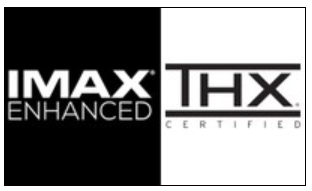Ed's
AV Handbook
Batting practice for the AV Professional
and primer for the novice
Chapter 8 Page 2
Home Theater Sound by Design
The
THX
IMAX Enhanced Design

The THX logo has labeled a
profusion of audio and video product for decades. Yet
many folks wonder, what is THX? THX is simply home
theater standards that manufacturers and installers must
meet to be THX certified. THX's goal, recreate the THX
commercial theater experience.
THX, originally a division of
Lucasfilm, is now an independent company. THX is not a
standard such as Dolby or DTS. Yet THX does outline
minimum specifications for amplifiers and speakers such as
flat frequency response, low distortion, and low
noise. In addition, THX makes the following
assumptions:
- Many movie soundtracks mixed with a mid-range boost cause harsh-sounding playback in a home theater.
- Acoustical reflections from the floor and ceiling smear sound fields and distort the mid and higher frequencies.
- Compromised speaker placement stimulates room modes that distort audio.
- Listener placement near room boundaries creates excessive bass.
- Rear channel effects are often unconvincing via dated surround sound encoding.
As a result, THX standards institute the following modifications to the electronic processing and the speaker system.
- THX processing features 'ReEQ' and 'Timbre Match' that alters high frequency and mid-range output, which results in less harsh sound.
- THX standards decrease vertical dispersion of the front speaker system, which should result in less distorting acoustical-reflections from the floor and ceiling.
- THX specifies smaller front and rear speakers with processing that re-routes low-frequency sound to a subwoofer.
A single source of low bass, the subwoofer, simplifies the management of distorting low-frequency room modes.
- THX adds 'Boundary Gain Compensation' that filters excessive bass for seating near a room boundary.
- THX implements an optional rear dipole speaker design, which creates a more-diffused, less localized sound.
- THX offers 'Adaptive De-correlation', which creates a more spacious image from older rear channel sound mixes.
- Many movie soundtracks mixed with a mid-range boost cause harsh-sounding playback in a home theater.
- Acoustical reflections from the floor and ceiling smear sound fields and distort the mid and higher frequencies.
- Compromised speaker placement stimulates room modes that distort audio.
- Listener placement near room boundaries creates excessive bass.
- Rear channel effects are often unconvincing via dated surround sound encoding.
As a result, THX standards institute the following modifications to the electronic processing and the speaker system.
- THX processing features 'ReEQ' and 'Timbre Match' that alters high frequency and mid-range output, which results in less harsh sound.
- THX standards decrease vertical dispersion of the front speaker system, which should result in less distorting acoustical-reflections from the floor and ceiling.
- THX specifies smaller front and rear speakers with processing that re-routes low-frequency sound to a subwoofer.
A single source of low bass, the subwoofer, simplifies the management of distorting low-frequency room modes.
- THX adds 'Boundary Gain Compensation' that filters excessive bass for seating near a room boundary.
- THX implements an optional rear dipole speaker design, which creates a more-diffused, less localized sound.
- THX offers 'Adaptive De-correlation', which creates a more spacious image from older rear channel sound mixes.

Interest in THX has waned in
recent years, while IMAX certification has risen as a new
option.
Both seek to provide a commercial theater experience. But IMAX differs in two fundamental ways.
1. The Speaker
THX prescribes the speaker specifications listed above. IMAX home theater speaker certification seems based solely on high fidelity performance.
I said "seems based" because I have yet to find specific IMAX speaker specs. My conclusion is based on speakers that have been IMAX certified.
2. The Picture
IMAX commercial theater screens are based on a curved 1.4:1 or 1.9:1 aspect ratio. An IMAX Blu-ray disc offers a HD 1.78:1 or 1.9:1 aspect ratio.
1.78:1 must crop the original height of the IMAX film aspect ratio on a 1.78:1 HDTV screen. 1.9:1 requires the return of black bars on a HDTV screen.
Therefore, the ideal screen choice for IMAX is a projector and taller/larger projection 1:91 screen with optional masking.
Both seek to provide a commercial theater experience. But IMAX differs in two fundamental ways.
1. The Speaker
THX prescribes the speaker specifications listed above. IMAX home theater speaker certification seems based solely on high fidelity performance.
I said "seems based" because I have yet to find specific IMAX speaker specs. My conclusion is based on speakers that have been IMAX certified.
2. The Picture
IMAX commercial theater screens are based on a curved 1.4:1 or 1.9:1 aspect ratio. An IMAX Blu-ray disc offers a HD 1.78:1 or 1.9:1 aspect ratio.
1.78:1 must crop the original height of the IMAX film aspect ratio on a 1.78:1 HDTV screen. 1.9:1 requires the return of black bars on a HDTV screen.
Therefore, the ideal screen choice for IMAX is a projector and taller/larger projection 1:91 screen with optional masking.
Lastly
Given the IMAX and THX goal of providing a commercial theater experience, large horn speakers, as used in theaters, should also be considered.
Given the IMAX and THX goal of providing a commercial theater experience, large horn speakers, as used in theaters, should also be considered.
Though not THX or IMAX
prescribed, a mid/tweeter horn array can broaden mid and
high-frequency dispersion from the front row to the
last. This is particularly true for a larger room with
many rows of seating. However, this design may also
sacrifice optimum performance at the focal point of the room,
which might be your seat. In any case, if you seek an
IMAX presentation or accept THX assumptions & solutions,
then employ a THX or an IMAX enhanced design.
Ed's AV Handbook
Copyright 2007 Txu1-598-288 Revised 2024
Sponsored By

Architectural Speaker Tuning System
for
in-wall/ceiling custom installed speakers.
Reclaim
The Performance You Paid For
Site Menu
Home
Table of
Contents
Handbook Chapters
1 AV
Terms
2 AV Physics
3 Sound Reproduction
4 Video Reproduction
5 The AV System Sequence
6 The Room, Speaker, & TV
7 Acoustical Strategy - Small Room
8 Home Theater by Design
9 AV Sales Training
10 AV Business & Marketing
Contact
About